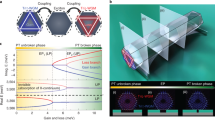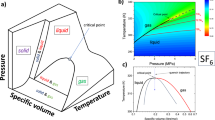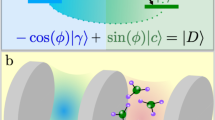Abstract
The ability to drive a system with an external input is a fundamental aspect of light–matter interaction. The key concept in many photonic applications is the ‘critical coupling’ condition1,2: at criticality, all the energy fed to the system is dissipated within the system itself. Although this idea was crucial to enhance the efficiency of many devices, it was never considered in the context of systems operating in a non-perturbative regime. In this so-called strong-coupling regime, the matter and light degrees of freedom are mixed into dressed states, leading to new eigenstates called polaritons3,4,5,6,7,8,9,10. Here we demonstrate that the strong-coupling regime and the critical coupling condition can coexist; in such a strong critical coupling situation, all the incoming energy is converted into polaritons. A general semiclassical theory reveals that such a situation corresponds to a special curve in the phase diagram of the coupled light–matter oscillators. In the case of a system with two radiating ports, the phenomenology shown is that of coherent perfect absorption (CPA; refs 11, 12), which is then naturally understood in the framework of critical coupling. Most importantly, we experimentally verify polaritonic CPA in a semiconductor-based intersubband-polariton photonic crystal resonator. This result opens new avenues in polariton physics, making it possible to control the pumping efficiency of a system independent of the energy exchange rate between the electromagnetic field and the material transition.
This is a preview of subscription content, access via your institution
Access options
Subscribe to this journal
Receive 12 print issues and online access
$259.00 per year
only $21.58 per issue
Buy this article
- Purchase on SpringerLink
- Instant access to full article PDF
Prices may be subject to local taxes which are calculated during checkout



Similar content being viewed by others
References
Haus, H. Waves and Fields in Optoelectronics (Prentice-Hall, 1984).
Yariv, A. & Yeh, P. Photonics—Optical Electronics in Modern Communications (Oxford Univ. Press, 2007).
Kaluzny, Y., Goy, P., Gross, M., Raimond, J. M. & Haroche, S. Observation of self-induced Rabi oscillations in two-level atoms excited inside a resonant cavity: The ringing regime of superradiance. Phys. Rev. Lett. 51, 1175–1178 (1983).
Thompson, R. J., Rempe, G. & Kimble, H. J. Observation of normal-mode splitting for an atom in an optical cavity. Phys. Rev. Lett. 68, 1132–1135 (1992).
Weisbuch, C., Nishioka, M., Ishikawa, A. & Arakawa, Y. Observation of the exciton–photon mode splitting in a semiconductor quantum microcavity. Phys. Rev. Lett. 69, 3314–3317 (1992).
Dini, D., Köhler, R., Tredicucci, A., Biasiol, G. & Sorba, L. Microcavity polariton splitting of intersubband transitions. Phys. Rev. Lett. 90, 116401 (2003).
Reithmaier, J. P. et al. Strong coupling in a single quantum dot-semiconductor microcavity system. Nature 432, 197–200 (2004).
Yoshie, T. et al. Vacuum Rabi splitting with a single quantum dot in a photonic crystal nanocavity. Nature 432, 200–203 (2004).
Peter, E. et al. Exciton–photon strong-coupling regime for a single quantum dot embedded in a microcavity. Phys. Rev. Lett. 95, 067401 (2005).
Amo, A. et al. Collective fluid dynamics of a polariton condensate in a semiconductor microcavity. Nature 457, 291–295 (2009).
Chong, Y. D., Ge, L., Cao, H. & Stone, A. D. Coherent perfect absorbers: Time-reversed lasers. Phys. Rev. Lett. 105, 053901 (2010).
Wan, W. et al. Time-reversed lasing and interferometric control of absorption. Science 331, 889–892 (2011).
Yu, Z., Raman, A. & Fan, S. Thermodynamic upper bound on broadband light coupling with photonic structures. Phys. Rev. Lett. 109, 173901 (2012).
Ghebrebrhan, M. et al. Tailoring thermal emission via Q matching of photonic crystal resonances. Phys. Rev. A 83, 033810 (2011).
Kimble, H. J. in Cavity Quantum Electrodynamics (ed Berman, P. R.) 203–266 (Academic, 1994).
Andreani, L. C., Panzarini, G. & Gérard, J-M. Strong-coupling regime for quantum boxes in pillar microcavities: Theory. Phys. Rev. B 60, 13276–13279 (1999).
Srinivasan, K. & Painter, O. Mode coupling and cavity–quantum-dot interactions in a fiber-coupled microdisk cavity. Phys. Rev. A 75, 023814 (2007).
Auffeves-Garnier, A., Simon, C., Gérard, J-M. & Poizat, J-P. Giant optical nonlinearity induced by a single two-level system interacting with a cavity in the Purcell regime. Phys. Rev. A 75, 053823 (2007).
Shen, J-T. & Fan, S. Theory of single-photon transport in a single-mode waveguide. I. Coupling to a cavity containing a two-level atom. Phys. Rev. A 79, 023837 (2009).
Shen, J-T. & Fan, S. Theory of single-photon transport in a single-mode waveguide. II. Coupling to a whispering-gallery resonator containing a two-level atom. Phys. Rev. A 79, 023838 (2009).
Shen, J-T. & Fan, S. Quantum critical coupling conditions for zero single-photon transmission through a coupled atom-resonator-waveguide system. Phys. Rev. A 82, 021802(R) (2010).
Dietze, D., Unterrainer, K. & Darmo, J. Role of geometry for strong coupling in active terahertz metamaterials. Phys. Rev. B 87, 075324 (2013).
Savona, V., Andreani, L. C., Schwendimann, P. & Quattropani, A. Quantum well excitons in semiconductor microcavities: Unified treatment of weak and strong coupling regimes. Solid State Commun. 93, 733–739 (1995).
De Liberato, S. & Ciuti, C. Stimulated scattering and lasing of intersubband cavity polaritons. Phys. Rev. Lett. 102, 136403 (2009).
De Liberato, S., Ciuti, C. & Phillips, C. C. Terahertz lasing from intersubband polariton–polariton scattering in asymmetric quantum wells. Phys. Rev. B 87, 241304(R) (2013).
Fan, S., Suh, W. & Joannopoulos, J. D. Temporal coupled-mode theory for the Fano resonance in optical resonators. J. Opt. Soc. Am. A 20, 569–572 (2003).
Zanotto, S., Degl’Innocenti, R., Sorba, L., Tredicucci, A. & Biasiol, G. Analysis of line shapes and strong coupling with intersubband transitions in one-dimensional metallo-dielectric photonic crystal slabs. Phys. Rev. B 85, 035307 (2012).
Chutinan, A. & John, S. Light trapping and absorption optimization in certain thin-film photonic crystal architectures. Phys. Rev. A 78, 023825 (2008).
Auffeves, A. et al. Controlling the dynamics of a coupled atom-cavity system by pure dephasing. Phys. Rev. B 81, 245419 (2010).
Degl’Innocenti, R., Zanotto, S., Tredicucci, A., Biasiol, G. & Sorba, L. One-dimensional surface-plasmon gratings for the excitation of intersubband polaritons in suspended membranes. Solid State Commun. 151, 1725–1727 (2011).
Manceau, J. M., Zanotto, S., Sagnes, I., Beaudoin, G. & Colombelli, R. Optical critical coupling into highly confining metal–insulator–metal resonators. Appl. Phys. Lett. 103, 091110 (2013).
Barnett, S. M., Jeffers, J., Gatti, A. & Loudon, R. Quantum optics of lossy beam splitters. Phys. Rev. A 57, 2134–2145 (1998).
Acknowledgements
We would like to thank G. Scamarcio and M. Liscidini for several fruitful interactions and discussions, E. Zanotto for providing us the loudspeaker actuator, and V. Spagnolo for valuable support with the laser source. This work was supported in part by the Italian Ministry for Economic Development through the Teragraph project and by the European Research Council through the Advanced Grant SoulMan. R.C. acknowledges partial support from the ERC GEM grant (Grant Agreement No. 306661).
Author information
Authors and Affiliations
Contributions
S.Z., F.P.M. and F.B. performed the experiment, G.B. grew the sample, S.Z., F.P.M., F.B., L.B., R.C. and A.T. analysed the data, S.Z., G.B., L.B., M.S.V., L.S., R.C. and A.T. devised the experiment, L.S., R.C. and A.T. coordinated the project. All authors contributed to the writing of the manuscript.
Corresponding author
Ethics declarations
Competing interests
The authors declare no competing financial interests.
Supplementary information
Supplementary Information
Supplementary Information (PDF 615 kb)
Rights and permissions
About this article
Cite this article
Zanotto, S., Mezzapesa, F., Bianco, F. et al. Perfect energy-feeding into strongly coupled systems and interferometric control of polariton absorption. Nature Phys 10, 830–834 (2014). https://doi.org/10.1038/nphys3106
Received:
Accepted:
Published:
Issue date:
DOI: https://doi.org/10.1038/nphys3106
This article is cited by
-
Coherent full polarization control based on bound states in the continuum
Nature Communications (2022)
-
Optical response mediated by a two-level system in the hybrid optomechanical system
Quantum Information Processing (2018)
-
Observation of the exceptional point in cavity magnon-polaritons
Nature Communications (2017)
-
Coherent perfect absorbers: linear control of light with light
Nature Reviews Materials (2017)
-
Wave Manipulations by Coherent Perfect Channeling
Scientific Reports (2017)



